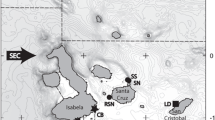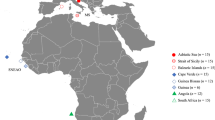Abstract
Genetic effective population size (Ne) estimators are useful as applied conservation tools. Many elasmobranch (shark and ray) species are threatened at local and global scales, and tools to monitor these populations are greatly needed. This study investigates contemporary Ne and its relationship with census size (Nc) in a population of zebra sharks (Stegostoma fasciatum). Our Ne using the linkage disequilibrium method, 377 (95 % CI 274–584) was found to closely approximate the mark-recapture Nc for this population of mature sharks (458, 95 % CI 298–618), with an Ne/Nc ratio of 0.82 (SE = 0.33). Furthermore, we conducted a series of sensitivity analyses to examine how the numbers of samples and loci affect the precision and accuracy of the estimators. We demonstrate that for this species robust and precise estimates are obtainable with a minimum of 91 samples (approximately 20 % of the census population) and 10 microsatellite loci. These findings contribute important information to the greater body of Ne and Ne/Nc relationships in elasmobranchs and wildlife populations as well as provide important guidelines for implementing genetic monitoring in elasmobranch conservation efforts.





Similar content being viewed by others
References
Ahonen H, Harcourt RG, Stow AJ (2009) Nuclear and mitochondrial DNA reveals isolation of imperilled grey nurse shark populations (Carcharias taurus). Mol Ecol 18:4409–4421
Antao T, Perez-Figueroa A, Luikart G (2010) Early detection of population declines: high power of genetic monitoring using effective population size estimators. Evol Appl 4:144–154
Baalsrud HT, Saether BE, Hagen IJ et al (2014) Effects of population characteristics and structure on estimates of effective population size in a house sparrow metapopulation. Mol Ecol 23:2653–2668
Begon M, Harper MJ, Townsend CR (1990) Ecology: individuals, populations and communities, 2nd edn. Blackwell, Cambridge
Blower DC, Pandolfi JM, Bruce BD, Gomez-Cabrera M, Ovenden JR (2012) Population genetics of Australian white sharks reveals fine-scale spatial structure, transoceanic dispersal events and low effective population sizes. Mar Ecol Prog Ser 455:229–244
Carrier JC, Pratt HL, Castro JI (2004) Reproductive biology of elasmobranchs. In: Carrier JC, Musick JA, Heithaus MR (eds) Biology of sharks and their relatives. CRC Press, Boca Raton, pp 269–286
Chapman DD, Simpfendorfer CA, Wiley TR et al (2011) Genetic diversity despite population collapse in a critically endangered marine fish: the smalltooth sawfish (Pristis pectinata). J Hered 102:643–652
Charlesworth B (2009) Fundamental concepts in genetics: effective population size and patterns of molecular evolution and variation. Nat Rev Genet 10:195–205
Chavez FP, Ryan J, Lluch-Cota SE, Ñiquel MC (2003) From anchovies to sardines and back: multidecadal change in the Pacific Ocean. Science 299:217–221
Chevolot M, Ellis JR, Rijnsdorp AD, Stam WT, Olsen JL (2008) Temporal changes in allele frequencies but stable genetic diversity over the past 40 years in the Irish Sea population of thornback ray, Raja clavata. Heredity 101:120–126
Cortés E (2004) Life history patterns, demography, and population dynamics. In: Carrier JC, Musick JA, Heithaus MR (eds) Biology of the sharks and their relatives. CRC Press, Florida
Do C, Waples RS, Peel D et al (2014) NeEstimator V2: re-implementation of software for the estimation of contemporary effective population size (Ne) from genetic data. Mol Ecol Resour 14:209–214
Dudgeon CL, Feldheim KA, Schick M, Ovenden JR (2006) Polymorphic microsatellite loci for the zebra shark Stegostoma fasciatum. Mol Ecol Notes 6:1086–1088
Dudgeon CL, Noad MJ, Lanyon JM (2008) Abundance and demography of a seasonal aggregation of zebra sharks Stegostoma fasciatum. Mar Ecol Prog Ser 368:269–281
Dudgeon CL, Broderick D, Ovenden JR (2009) IUCN classification zones concord with, but underestimate, the population genetic structure of the zebra shark Stegostoma fasciatum in the Indo-West Pacific. Mol Ecol 18:248–261
Dudgeon CL, Blower DC, Broderick D, Giles JL, Holmes BJ, Kashiwagi T, Krück NC, Morgan JAT, Tillett BJ, Ovenden JR (2012) A review of the application of molecular genetics for fisheries management and conservation of sharks and rays. J Fish Biol 80:1789–1843. doi:10.1111/j.1095-8649.2012.03265.x
Dudgeon CL, Lanyon JM, Semmens JM (2013) Seasonality and site fidelity of the zebra shark, Stegostoma fasciatum, in southeast Queensland, Australia. Anim Behav 85:471–481
Dulvy NK, Fowler SL, Musick JA et al (2014) Extinction risk and conservation of the world’s sharks and rays. eLife 3:e00590
Ferretti F, Worm B, Britten GL, Heithaus MR, Lotze HK (2010) Patterns and ecosystem consequences of shark declines in the ocean. Ecol Lett 13:1055–1071
Frankham R (1995) Effective population size/adult population size ratios in wildlife: a review. Genet Res 66:95–107
Frankham R, Ballou JD, Briscoe DA (2010) Introduction to conservation genetics, 2nd edn. Cambridge University Press, Cambridge
Franklin IR (1980) Evolutionary change in small populations. In: Soule ME, Wilcox BA (eds) Conservation biology: an evolutionary-ecological perspective. Sinauer Associates, Sunderland, pp 135–150
Frisk MG (2010) Life history strategies of batoids. In: Carrier JC, Musick JA, Heithaus MR (eds) Sharks and their relatives II: biodiversity, adaptive physiology, and conservation. CRC Press, Boca Raton, pp 283–307
Hare MP, Nunney L, Schwartz MK et al (2011) Understanding and estimating effective population size for practical application in marine species management. Conserv Biol 25:438–449
Hauser L, Adcock GJ, Smith PJ, Ramirez JHB, Carvalho GR (2002) Loss of microsatellite diversity and low effective population size in an overexploited population of New Zealand snapper (Pagrus auratus). Proc Natl Acad Sci USA 99:11742–11747
Hedgecock D (1994) Does variance in reproductive success limit effective population sizes of marine organisms? In: Beaumont AR (ed) Genetics and evolution of aquatic organisms. Chapman & Hall, London, pp 122–134
Kendall MG, Stuart A (1987) The advanced theory of statistics vol I, 4th edn. Charles Griffen & Company, London, p 351
Lande R (1995) Mutation and conservation. Conserv Biol 9:782–791
Luikart G, Ryman N, Tallmon DA, Schwartz MK, Allendorf FW (2010) Estimation of census and effective population sizes: the increasing usefulness of DNA-based approaches. Conserv Genet 11:355–373
Macbeth GM, Broderick D, Buckworth RC, Ovenden JR (2013) Linkage disequilibrium estimation of effective population size with immigrants from divergent populations: a case study on spanish mackerel (Scomberomorus commerson). G3 3:709–717
Musick JA (1999) Ecology and conservation of long-lived marine animals. In: Musick JA (ed) Life in the slow lane: ecology and conservation of long lived marine animals. American Fisheries Society Symposium, Bethesda, pp 1–10
Musick JA, Elllis JK (2005) Reproductive evolution of chondrichthyans. In: Hamlett WC (ed) Reproductive biology and phylogeny of chondricthyes. Science Publishers Inc., Enfield, pp 1–25
Otway NM, Burke AL (2004) Mark-recapture population estimate and movements of grey nurse sharks. In: NSW Department of Primary Industries Fisheries Final Report Series. NSW Fisheries Office of Conservation, Nelson Bay, Australia
Ovenden JR, Peel D, Street R et al (2007) The genetic effective and adult census size of an Australian population of tiger prawns (Penaeus esculentus). Mol Ecol 16:127–138
Ozerov M, Jurgenstein T, Aykanat T, Vasemagi A (2015) Use of sibling relationship reconstruction to complement traditional monitoring in fisheries management and conservation of brown trout. Conserv Biol. doi:10.1111/cobi.12480
Palstra FP, Fraser DJ (2012) Effective/census population size ratio estimation: a compendium and appraisal. Ecol Evol 2:2357–2365
Palstra FP, Ruzzante DE (2008) Genetic estimates of contemporary effective population size: what can they tell us about the importance of genetic stochasticity for wild population persistence? Mol Ecol 17:3428–3447
Peakall R, Smouse PE (2006) GENALEX 6: a genetic analysis in Excel. Population genetic software for teaching and research. Mol Ecol Notes 6:288–295
Peel D, Waples RS, Macbeth GM, Do C, Ovenden JR (2013) Accounting for missing data in the estimation of contemporary genetic effective population size (Ne). Mol Ecol Resour 13:243–253
Pillans RD, Simpfendorfer CA (2003) Zebra shark, Stegostoma fasciatum (Hermann, 1973). In: Cavanagh RD, Kyne PM, Fowler SL, Musick JA, Bennett MB (eds) The conservation of status Australasian Chondricthyans: report of the IUCN Shark Specialist Group Australia and Oceania Regional Red List Workshop. IUCN, Brisbane
Portnoy DS, McDowell JR, McCandless CT, Musick JA, Graves JE (2009) Effective size closely approximates the census size in the heavily exploited western Atlantic population of the sandbar shark, Carcharhinus plumbeus. Conserv Genet 10:1697–1705
R Development Core Team (2013) R: a language and environment for statistical computing. R Foundation for Statistical Computing, Vienna
Raymond M, Rousset F (1995) GENEPOP (version 1.2): population genetics software for exact tests and ecumenicism. J Hered 86:248–249
Reed DH, Frankham R (2003) Correlation between fitness and genetic diversity. Conserv Biol 17:230–237
Sminkey T, Musick JA (1996) Demographic analysis of the sandbar shark, Carcharhinus plumbeus, in the western North Atlantic. Fish Bull 61:1–38
Sollman R, Gardner B, Parsons AW et al (2013) A spatial mark-resight model augmented with telmetry data. Ecology 94:553–559
Tallmon DA, Gregovich D, Waples RS et al (2010) When are genetic methods useful for estimating contemporary abundance and detecting population trends? Mol Ecol Resour 10:684–692
van Oosterhout C, Hutchinson WF, Wills DPM, Shipley P (2004) MICRO-CHECKER: software for identifying and correcting genotying errors in microsatellite data. Mol Ecol Notes 4:535–538
Wang JL, Whitlock MC (2003) Estimating effective population size and migration rates from genetic samples over space and time. Genetics 163:429–446
Waples RS (2006) A bias correction for estimates of effective population size based on linkage disequilibrium at unlinked gene loci. Conserv Genet 7:167–184
Waples RS, Do C (2010) Linkage disequilibrium estimates of contemporary Ne using highly variable genetic markers: a largely untapped resource for applied conservation and evolution. Evol Appl 3:244–262
Waples RS, England PR (2011) Estimating contemporary effective population size on the basis of linkage disequilibrium in the face of migration. Genetics 189:633–644
Waples RS, Luikart G, Faulkner JR, Tallmon DA (2013) Simple life-history traits explain key effective population size ratios across diverse taxa. Proc Biol Sci 280:20131339
Waples RS, Antao T, Luikart G (2014) Effects of overlapping generations on linkage disequilibrium estimates of effective population size. Genetics 197:769–780
Whiteley AR, Coombs JA, Hudy M et al (2012) Sampling strategies for estimating brook trout effective population size. Conserv Genet 13:625–637
Worm B, Davis B, Kettemer L et al (2013) Global catches, exploitation rates, and rebuilding options for sharks. Mar Policy 40:194–204
Wright S (1931) Evolution in Mendelian populations. Genetics 16:97–159
Acknowledgements
This project was funded by The Sea World Research and Rescue Foundation and The University of Queensland. We thank numerous field assistants, in particular Adam Barnett, Cynthia Awruch, Michael Williamson, Lydie Couturier, Rob Slade, Jody Kreuger and Angela Dean. Thanks to Sean Corley and the Animal Genetics Laboratory, Gatton, UQ for genotyping data; Dean Blower and Tom Kashiwagi for informative discussions; Lucy Ransome for photo-ID matching and Matias Braccini and Adrian Thomson for analytical assistance.
Author information
Authors and Affiliations
Corresponding author
Electronic supplementary material
Below is the link to the electronic supplementary material.
Rights and permissions
About this article
Cite this article
Dudgeon, C.L., Ovenden, J.R. The relationship between abundance and genetic effective population size in elasmobranchs: an example from the globally threatened zebra shark Stegostoma fasciatum within its protected range. Conserv Genet 16, 1443–1454 (2015). https://doi.org/10.1007/s10592-015-0752-y
Received:
Accepted:
Published:
Issue Date:
DOI: https://doi.org/10.1007/s10592-015-0752-y




